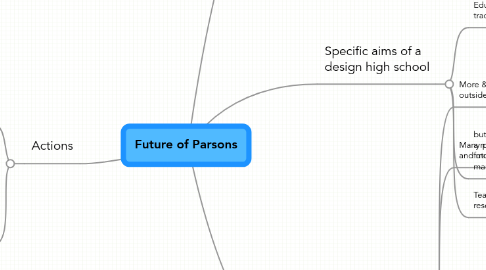
1. Actions
1.1. Knowing all this & more (like Parsons specific figures & metrics..etc), make a SWOT analysis of Parsons
1.1.1. Strenghts
1.1.2. Weaknesses
1.1.3. Opportunities
1.1.4. Threats
1.2. Use design thinking (and its methods) for developing the future model of Parsons based on all this knowledge & Parsons specific environmental parameters (including demographic, institutional, politcial, sociologcal, cultural...etc ones)
2. Aims of a high school
2.1. Provide (complex) knowledge on a specific speciality
2.2. Additionally provide a good general education in other (important) disciplines
2.3. Learn students how to learn and get new knowledge during their whole life
2.4. Build professional communities
2.5. Provide a physical social space for encounters & social learning
2.6. Provide physical & virtual infrastructures for teaching & learning
2.7. Prepare students to the professional world and a job
2.8. Evaluate & choose taught materials according to scientific criteria
3. Specific aims of a design high school
3.1. Educate designers in different traditional design disciplines
3.1.1. Industrial design
3.1.2. Product design
3.1.3. Graphic design
3.1.4. Digital design
3.1.5. Fashion design
3.1.6. UX design
3.1.7. Service design
3.1.8. etc
3.2. but also: educate design thinkers able to participate at a more strategic level of building many aspects of our future world as "design thinking" is becoming a new management paradigm
3.3. Teach common design stuff like design research, psychology, arts,...etc
4. Current & future socio-economic and cultural context
4.1. More & more alumni work in areas outside their original study discipline
4.2. Many people have high school diplomas and more & more will get one
4.2.1. Higher competition between students
4.2.2. Decreased value of a single diploma
4.2.3. Higher competition between High schools
4.3. Complex interconnected world
4.3.1. Need for multidisplinary educated students
4.3.2. Higher need for design thinking taught designers as they get needed in the business & public sector worlds at different levels (mainly because of their interdisciplinary & creative skills)
4.3.3. Exponential pace of evolution & new knowledge creation
4.3.4. The world faces complex multiple (also contradictory challenges) - existing & new - that never existed in that way before
4.3.5. Higher need for early practical experiences of students
4.3.5.1. Training periods
4.3.5.2. And multi channel collaboration, exchange & communication with professionals out there
4.4. Self-organization of existing and new communities of practice (possible because of the Internet revolution) & much higher pace of diverse knowledge creation, sharing and distribution
4.4.1. which also means self-organization of the learning process
4.4.2. new disciplines are quicker in producing & sharing theories, tools, methods and case studies than universities in adopting them on their programs (example: the UX design community)
4.4.2.1. Designers seem to be me more at the forefront of the Internet revolution & more willing to collaborate & share information then the average professional community
4.4.2.2. In the near future there will be DIGITAL NATIVES only
